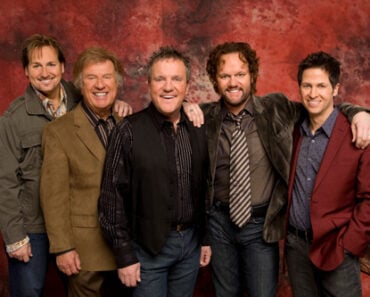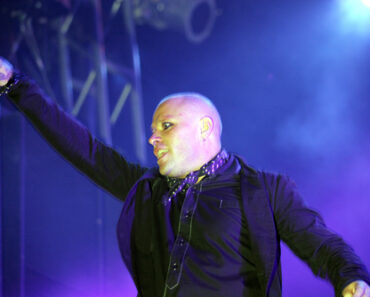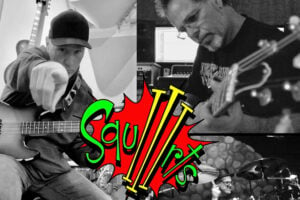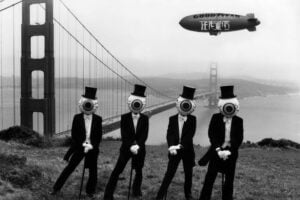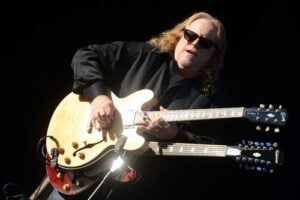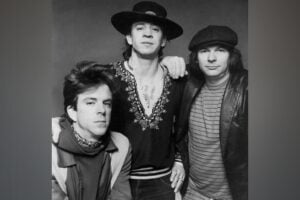
Feature Photo: Don Hunstein, Public domain, via Wikimedia Commons
Hands down, Stevie Ray Vaughan stands as not only one of the greatest guitar players who has ever lived, but also one of the most passionate playing musicians of all time. And of course, when you talk about Steve Ray Vaughan, we also need to mention his band Double Trouble. The group formed in 1978 and released four studio albums and one live album during Vaughan’s lifetime, selling more than 11.5 million records in the United States alone. All four studio albums achieved platinum certification, and Vaughan won four Grammy Awards with his backing band. Following Vaughan’s death in a helicopter crash on August 27, 1990, the surviving members of Double Trouble continued performing in various capacities, and in 2015, Stevie Ray Vaughan and Double Trouble were inducted into the Rock and Roll Hall of Fame.
Vaughan’s commercial and critical success was built on relentless touring throughout Texas clubs in the early 1980s with his backing band, which led to their breakthrough performance at the Montreux Jazz Festival in 1982. His debut album, Texas Flood, was released in June 1983 and peaked at number 38 on the Billboard 200. The follow-up album, Couldn’t Stand the Weather, reached number 31 in 1984. Soul to Soul was released in 1985, followed by the live album Live Alive in 1986. His final studio album, In Step, was released in June 1989, peaked at number 33 on the charts, and won a Grammy Award for Best Contemporary Blues Recording. The backing band lineup underwent several changes during its early formation period before Vaughan settled on the core trio of Chris Layton on drums and Tommy Shannon on bass, later expanding to a quartet with the addition of Reese Wynans on keyboards in 1985.
Vaughan’s influence extended beyond his commercial achievements, as he played a significant role in the blues revival of the 1980s and inspired numerous subsequent blues and rock musicians. His virtuosic guitar playing, supported by his tight rhythm section, created a distinctive sound that resonated with audiences worldwide. Vaughan performed at major venues including Carnegie Hall and appeared on network television programs, bringing blues music back into the mainstream during a period when it had largely faded from popular consciousness. His posthumous releases, overseen by his brother Jimmie, continued to achieve commercial success and introduced new generations to his music.
Stevie Ray Vaughan
Stevie Ray Vaughan served as the bandleader, guitarist, and vocalist from the band’s formation in 1978 until his death in 1990. Born on October 3, 1954, in Dallas, Texas, Vaughan began playing guitar at age seven and dropped out of high school in 1972 to pursue music full-time in Austin. Before forming his own backing band, he played in several groups including Blackbird and Paul Ray and the Cobras, with the Cobras being named Austin’s Band of the Year in 1976.
In September 1977, Vaughan formed Triple Threat Revue, which eventually evolved into Double Trouble when the name was changed in May 1978, taken from an Otis Rush song. When vocalist Lou Ann Barton left in 1979, Vaughan took over lead vocal duties himself and became the sole frontman. He released four studio albums with Double Trouble backing him: Texas Flood, Couldn’t Stand the Weather, Soul to Soul, and In Step. Vaughan contributed guitar work to David Bowie’s Let’s Dance album in 1983, playing lead guitar on six of the eight tracks, which became Bowie’s best-selling record. Vaughan was known for primarily playing a 1963 Fender Stratocaster body with a 1962 neck, which he referred to as his “first wife” or “Number One.”
He performed at venues ranging from small Texas clubs to Carnegie Hall and international festivals, with his backing band providing the rhythm section that supported his guitar virtuosity. Vaughan died on August 27, 1990, when the helicopter transporting him from a concert at Alpine Valley Music Theatre in Wisconsin crashed shortly after takeoff. He was posthumously inducted into the Rock and Roll Hall of Fame in 2015 alongside his Double Trouble bandmates, and his albums have sold over 15 million copies in the United States alone.
Chris Layton
Chris Layton, also known by his nickname “Whipper,” served as Stevie Ray Vaughan’s drummer from September 1978 until Vaughan’s death in 1990. Born on November 16, 1955, in Corpus Christi, Texas, Layton moved to Austin in December 1975 and initially joined the band Greezy Wheels. He met Vaughan through his roommate, saxophonist Joe Sublett, who played Texas blues and Chicago blues records for Layton to learn from. Vaughan personally tutored Layton in playing blues shuffle rhythms, sitting down with him to demonstrate the specific style he wanted for his backing band.
Layton provided the drum work on all four studio albums recorded with Vaughan: Texas Flood, Couldn’t Stand the Weather, Soul to Soul, and In Step. His drumming provided the foundational rhythm that supported Vaughan’s guitar playing, working in close partnership with bassist Tommy Shannon to create the tight rhythm section that backed the guitarist throughout his career. Following Vaughan’s death, Layton co-founded the Arc Angels in 1990 with guitarists Doyle Bramhall II and Charlie Sexton, and bassist Tommy Shannon. In 1994, he formed Storyville with David Lee Holt, David Grissom, and vocalist Malford Milligan.
Layton and Shannon released an album under the Double Trouble name titled Been a Long Time in 2001, which featured guest vocalists and guitarists including Willie Nelson, Dr. John, and others filling the frontman role that Vaughan had held. In 2003, Layton formed the band Grady with leader Gordie Johnson. He has worked extensively as a sideman for other artists including Jonny Lang, Kenny Wayne Shepherd, Eric Johnson, and Susan Tedeschi. Layton became the drummer for the Kenny Wayne Shepherd Band and was inducted into the Musician’s Hall of Fame, Austin City Limits, and the Rock and Roll Hall of Fame in 2015 as part of Stevie Ray Vaughan and Double Trouble.
Tommy Shannon
Tommy Shannon served as Stevie Ray Vaughan’s bassist from January 1981 until Vaughan’s death in 1990, replacing Jackie Newhouse in the backing band. Born Thomas Lafitte Smedley on April 18, 1946, in Tucson, Arizona, Shannon moved to Dumas, Texas, at age nine and initially played guitar before switching to bass at age 21. His professional career began in the late 1960s when he served as bassist for Johnny Winter, appearing on Winter’s self-titled debut album and Second Winter in 1969. Shannon performed with Winter at the historic Woodstock festival in 1969, gaining valuable experience backing a blues guitar virtuoso in high-profile performances.
When Winter joined a new band with Rick Derringer in 1970, Shannon found himself without a position and briefly formed the band Krackerjack, which at one point included a young Stevie Ray Vaughan. Shannon had first met Vaughan as a teenager at a Dallas club called The Fog and reconnected with him years later. In October 1980, while playing with Alan Haynes in Houston, Shannon attended a Vaughan performance at Rockefeller’s and jammed with the guitarist and his backing band, immediately knowing he wanted to join.
Shannon provided bass on Texas Flood, Couldn’t Stand the Weather, Soul to Soul, and In Step, and he co-wrote the hit song “Crossfire” from In Step. His bass playing was characterized by solid groove and melodic bass lines that supported and complemented Vaughan’s guitar work without overshadowing it. Shannon primarily played a 1962 Fender Jazz Bass that had been used by both Jimi Hendrix and BB King during jam sessions with Johnny Winter. After Vaughan’s death, Shannon co-founded the Arc Angels with Chris Layton, Doyle Bramhall II, and Charlie Sexton in 1990. He later formed Storyville in 1994 and released Been a Long Time with Layton in 2001 under the Double Trouble name. Shannon has also worked as a session bassist for numerous other artists including Little Jimmy King, Debbie Davies, and Nuno Mindelis. He was inducted into the Rock and Roll Hall of Fame in 2015 as a member of Stevie Ray Vaughan’s backing band.
Reese Wynans
Reese Wynans joined Stevie Ray Vaughan’s backing band as keyboardist in 1985 and performed with Vaughan until his death in 1990. Born on November 28, 1947, in Sarasota, Florida, Wynans grew up taking piano lessons and was the only one among his six siblings who truly embraced playing. Before joining Vaughan’s group, Wynans had an extensive musical background that included being a member of the Second Coming from November 1968 to March 1969, which featured future Allman Brothers Band members Dickey Betts and Berry Oakley. He was present at the initial jam session that led to the formation of the Allman Brothers Band but was replaced by vocalist Gregg Allman. Wynans also played with Captain Beyond in 1973 and worked with various artists including Boz Scaggs and Jerry Jeff Walker.
When Vaughan brought him into the backing band in 1985, Double Trouble expanded from a power trio to a quartet. Wynans played keyboards on the albums Soul to Soul and In Step, adding depth and texture to support Vaughan’s guitar work with his Hammond B3 organ playing. He contributed keyboard parts to memorable tracks including “Say What!” and “Riviera Paradise,” bringing his extensive experience in blues, rock, and jazz to support the guitarist’s recordings.
Following Vaughan’s death, Wynans joined the touring bands of Joe Ely and Lee Roy Parnell as a sideman. After moving to Nashville, Tennessee, in 1992, he became a highly sought-after session musician, playing on recordings for country artists including Brooks & Dunn, Trisha Yearwood, and Hank Williams Jr. Wynans has also worked with blues artists such as Buddy Guy, Kenny Wayne Shepherd, and Susan Tedeschi. He became the touring keyboardist for Joe Bonamassa in 2015, having previously played on Bonamassa’s 2014 album Different Shades of Blue. In 2019, Wynans released his first solo album, Sweet Release, featuring reunions with Tommy Shannon and Chris Layton. He was inducted into the Musician’s Hall of Fame, Austin City Limits, and the Rock and Roll Hall of Fame in 2015 as part of Stevie Ray Vaughan and Double Trouble.
Jackie Newhouse
Jackie Newhouse served as Stevie Ray Vaughan’s bassist from May 1978 until January 1981, when Tommy Shannon replaced him. Newhouse joined Vaughan’s backing band after W.C. Clark departed from the group that was then transitioning from Triple Threat Revue to Double Trouble. He had first met vocalist Lou Ann Barton in Fort Worth, and Barton auditioned and hired him when Vaughan’s band needed a bassist. Newhouse played during the formative years when Vaughan was establishing himself in the Austin club scene and building his reputation throughout Texas.
He performed in Vaughan’s backing band during their frequent residencies at venues like the Rome Inn in Austin and appeared at Rockefeller’s in Houston, where Tommy Shannon first saw Vaughan perform in October 1980. Newhouse was present during a jam session that night when Shannon sat in with the band, which ultimately led to Shannon’s hiring. The April 1, 1980, performance at the Steamboat 1874 club in Austin, which featured Newhouse on bass backing Vaughan, was recorded for radio and later released as the 1992 album In The Beginning. His tenure with Vaughan ended on January 2, 1981, when Shannon officially took over the bass position. After leaving Double Trouble, Newhouse continued his music career in Texas, later becoming a music educator at the New School of Music.
Lou Ann Barton
Lou Ann Barton served as the lead vocalist for Stevie Ray Vaughan’s band from 1978 until November 1979, during which time Vaughan focused primarily on guitar. Born on February 17, 1954, in Fort Worth, Texas, Barton moved to Austin in the mid-1970s and quickly became a prominent figure in the local blues scene. She initially joined Vaughan in the Triple Threat Revue in September 1977, which also featured W.C. Clark, Mike Kindred, Fredde Walden, and Johnny Reno. When the group transitioned to Double Trouble in May 1978 after Clark and Kindred departed, Barton remained as the lead vocalist while Vaughan focused on his guitar playing.
During her time with Vaughan’s band, Barton helped audition and hire bassist Jackie Newhouse. She performed with Vaughan throughout Texas, helping to build his reputation in clubs and establishing the group’s early identity as a blues revue with a featured female vocalist. In 1978, the band recorded material at Cowboy Jack Clement’s home studio in Nashville, though these recordings were never officially released and only circulated as bootlegs. When Barton and saxophonist Johnny Reno left the band in November 1979, Vaughan took over lead vocal duties himself and the group evolved into the guitar-centered power trio format that would define his most successful years.
Following her departure from Vaughan’s band, Barton went on to have a successful solo career. She joined Roomful of Blues in the early 1980s, where she was discovered by legendary producer Jerry Wexler. In 1982, she recorded her debut album Old Enough for Asylum Records, co-produced by Wexler and Glenn Frey. Her 1989 album Read My Lips for Antone’s Records marked a return to her blues roots and became highly regarded among blues enthusiasts. Barton collaborated with Marcia Ball and Angela Strehli on the album Dreams Come True in 1990. She has appeared on Austin City Limits multiple times, including a 1989 performance with the W.C. Clark Blues Revue alongside Stevie Ray Vaughan and Jimmie Vaughan, and again in 2001 as a guest of Double Trouble. She has also toured with Jimmie Vaughan and the Tilt-a-Whirl Band and continues to perform regularly in Austin and throughout Texas.
Fredde “Pharaoh” Walden
Fredde Walden, known by his nickname “Pharaoh,” was the original drummer for Triple Threat Revue and briefly for Stevie Ray Vaughan when the band became Double Trouble in the spring of 1978. Walden was part of the initial lineup when Vaughan formed Triple Threat Revue in September 1977, joining vocalist Lou Ann Barton, bassist W.C. Clark, keyboardist Mike Kindred, and saxophonist Johnny Reno. He was recommended to Vaughan by Mike Kindred, who insisted that Walden be brought into the group as the drummer.
During his time with Vaughan, Walden was known for his shuffle rhythm and swing style, with Jimmie Vaughan later noting that Walden had done extensive playing in his bands and could play simply while aspiring to emulate the drummers on early Albert Collins records. The band underwent a name change to Double Trouble in May 1978 when Clark and Kindred left the group, but Walden’s tenure as Vaughan’s drummer was short-lived. He departed in July 1978, just a few months into the band’s existence as Double Trouble. His position was briefly filled by Jack Moore before Chris Layton became Vaughan’s permanent drummer in September 1978. After leaving Vaughan’s band, Walden continued his career in the Austin music scene, playing with various local musicians. He later performed with Lou Ann Barton on tours in the 1990s, including a memorable European tour with Antone’s Records artists.
Jack Moore
Jack Moore served as Stevie Ray Vaughan’s drummer for approximately two to three months in the summer of 1978. A native of Providence, Rhode Island, Moore had moved to Austin, Texas, to pursue drumming opportunities in the thriving local music scene. He joined Vaughan’s backing band in July 1978 after Fredde Walden left, becoming part of the lineup that also included vocalist Lou Ann Barton, bassist Jackie Newhouse, and saxophonist Johnny Reno.
Moore’s tenure as Vaughan’s drummer was brief, as he decided to return to Providence to complete his college education after performing with the guitarist for about three months. His departure opened the position for Chris Layton, who would become Vaughan’s permanent drummer in September 1978 and remain with him throughout his entire career. Despite his short time backing Vaughan, Moore was part of the band during a crucial developmental period when the guitarist was establishing himself in Austin clubs. After returning to Rhode Island, Moore continued his musical career and was noted among the talented musicians who emerged from Hope High School in Providence during the mid-1970s. His brief connection to Stevie Ray Vaughan remains a footnote in the legendary guitarist’s early career.
Johnny Reno
Johnny Reno served as saxophonist in Stevie Ray Vaughan’s band from 1978 until 1979. He was part of the original lineup when the band transitioned from Triple Threat Revue to Double Trouble, joining Vaughan, vocalist Lou Ann Barton, bassist Jackie Newhouse, and the various drummers during this period. Reno had been a member of Triple Threat Revue since its formation in September 1977, performing alongside Vaughan, Barton, W.C. Clark, Mike Kindred, and Fredde Walden.
When the group’s name changed to Double Trouble in May 1978 following the departure of Clark and Kindred, Reno remained with Vaughan’s band, providing saxophone accompaniment to the blues-rock sound. His role added a horn element to Vaughan’s early performances, contributing to the fuller sound of the group during its formative period. Reno left Vaughan’s band in November 1979 at the same time as Lou Ann Barton, marking a significant shift in the guitarist’s direction. When both Barton and Reno departed, Vaughan took over lead vocal duties himself and the group evolved into the power trio format that would define his most successful years. The elimination of the saxophone from the lineup allowed Vaughan to focus on a tighter, more guitar-driven sound that became his signature. After leaving Vaughan’s band, Reno continued performing in the Austin music scene.
Check out more Stevie Ray Vaughan & Double Trouble articles on ClassicRockHistory.com Just click on any of the links below……
Top 10 Stevie Ray Vaughan Songs
Complete List Of Stevie Ray Vaughan Albums And Discography
Stevie Ray Vaughan David Bowie Tour: Why It Never Happened.
Stevie Ray Vaughan Albums Ranked
Storyville Band History Featuring Stevie Ray Vaughan’s Double Trouble
Read More: Artists’ Interviews Directory At ClassicRockHistory.com
Read More: Classic Rock Bands List And Directory
Complete List Of Stevie Ray Vaughan & Double Trouble Band Members article published on ClassicRockHistory.com© 2025
Classicrockhistory.com claims ownership of all its original content and Intellectual property under United States Copyright laws and those of all other foreign countries. No one person, business, or organization is allowed to re-publish any of our original content anywhere on the web or in print without our permission. All photos used are either public domain Creative Commons photos or licensed officially from Shutterstock under license with ClassicRockHistory.com. All photo credits have been placed at the end of the article. Album Cover Photos are affiliate links and the property of Amazon and are stored on the Amazon server. Any theft of our content will be met with swift legal action against the infringing websites.


